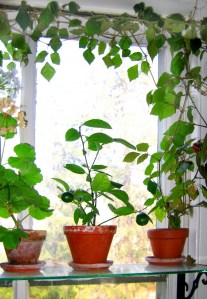Last updated on December 2nd, 2011
 Click here to read an updated version of this post. I may not want the lemons that life delivers, but I always cherish those I pick myself, from the citrus tree that grows in my sunny library window. This is the Meyer Lemon, Citrus meyerii, which grows no taller than 12 inches for several years, yet produces good-sized fruit while still a young plant. The lemons are prized by gourmets for their sweet, not tart flavor. Both flowers and fruit are intensely fragrant.
Click here to read an updated version of this post. I may not want the lemons that life delivers, but I always cherish those I pick myself, from the citrus tree that grows in my sunny library window. This is the Meyer Lemon, Citrus meyerii, which grows no taller than 12 inches for several years, yet produces good-sized fruit while still a young plant. The lemons are prized by gourmets for their sweet, not tart flavor. Both flowers and fruit are intensely fragrant.
Meyer is the friendliest of fruiting plants. It enjoys warm days (not exceeding 65 degrees), cool nights (55 degrees), full sunlight and moderate humidity. Any light, porous potting soil will do, but a clay pot is essential, in order to provide air to the plant’s substantial root system and to facilitate dryness between waterings. A five-inch pot is suitable for the first two or three years of growth.
To produce the strong limbs and bushy form that will support a crop of heavy crop, prune the plant while it is young. I like to accomplish this in late spring after flowering, and while the plant is in an active cycle of growth.
Overwatering is the error of novices. Only when the top soil appears dry should you water thoroughly, until the entire root mass is saturated, and excess drips through the drainage hole. Be sure to empty the saucer immediately afterward. I feed my plant with every watering, using a 1/4 teaspoon of Miracid dissolved in a gallon of room-temperature water.
Such is the easy culture that guarantees a cloud of fragrant, white blossoms in December and April, and off and on again throughout the year. The flowers, which are self-pollinating, are white with a pink cast.
It is the lemons, however, that steal the show. These typically appear in clusters of six. Pinch off all but two or three lemons per cluster to achieve full-sized fruit of the highest quality. When the lemons turn from green to bright yellow in the fall, they are ready for harvesting.
In late May, when all danger of frost has past, bring the plant to a shady area outdoors. Over a ten day period, gradually introduce it to longer periods of sun until, without scorching, it can handle a position in full sunlight. By summer’s end reverse the procedure, slowly moving the plant to shadier conditions, and then to your sunniest window garden.
Flowers, fruit and fragrance — these are the bountiful offerings of the Meyer Lemon. You will not find an easier fruiting plant for your sunny window garden. (photo: R.H. Blackburn)

Holly says
Kevin, I MUST get a Meyer lemon! But where from???
Gardenlady says
Same question as Holly.
Kevin Lee Jacobs says
Holly and Gardenlady – my favorite source for dwarf, house-tolerant citrus is Logee's Greenhouses in Danielson, CT. You can reach them at http://www.logees.com